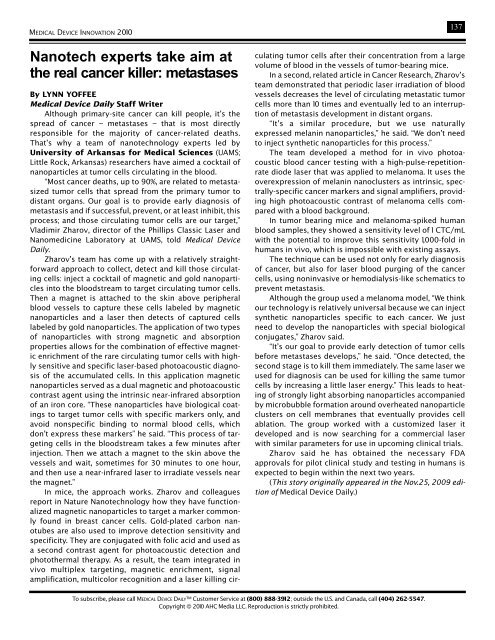MEDICAL DEVICE INNOVATION - Medical Device Daily
MEDICAL DEVICE INNOVATION - Medical Device Daily
MEDICAL DEVICE INNOVATION - Medical Device Daily
You also want an ePaper? Increase the reach of your titles
YUMPU automatically turns print PDFs into web optimized ePapers that Google loves.
<strong>MEDICAL</strong> <strong>DEVICE</strong> <strong>INNOVATION</strong> 2010<br />
Nanotech experts take aim at<br />
the real cancer killer: metastases<br />
137<br />
By LYNN YOFFEE<br />
<strong>Medical</strong> <strong>Device</strong> <strong>Daily</strong> Staff Writer<br />
Although primary-site cancer can kill people, it’s the<br />
spread of cancer – metastases – that is most directly<br />
responsible for the majority of cancer-related deaths.<br />
That’s why a team of nanotechnology experts led by<br />
University of Arkansas for <strong>Medical</strong> Sciences (UAMS;<br />
Little Rock, Arkansas) researchers have aimed a cocktail of<br />
nanoparticles at tumor cells circulating in the blood.<br />
“Most cancer deaths, up to 90%, are related to metastasized<br />
tumor cells that spread from the primary tumor to<br />
distant organs. Our goal is to provide early diagnosis of<br />
metastasis and if successful, prevent, or at least inhibit, this<br />
process; and those circulating tumor cells are our target,”<br />
Vladimir Zharov, director of the Phillips Classic Laser and<br />
Nanomedicine Laboratory at UAMS, told <strong>Medical</strong> <strong>Device</strong><br />
<strong>Daily</strong>.<br />
Zharov’s team has come up with a relatively straightforward<br />
approach to collect, detect and kill those circulating<br />
cells: inject a cocktail of magnetic and gold nanoparticles<br />
into the bloodstream to target circulating tumor cells.<br />
Then a magnet is attached to the skin above peripheral<br />
blood vessels to capture these cells labeled by magnetic<br />
nanoparticles and a laser then detects of captured cells<br />
labeled by gold nanoparticles. The application of two types<br />
of nanoparticles with strong magnetic and absorption<br />
properties allows for the combination of effective magnetic<br />
enrichment of the rare circulating tumor cells with highly<br />
sensitive and specific laser-based photoacoustic diagnosis<br />
of the accumulated cells. In this application magnetic<br />
nanoparticles served as a dual magnetic and photoacoustic<br />
contrast agent using the intrinsic near-infrared absorption<br />
of an iron core. “These nanoparticles have biological coatings<br />
to target tumor cells with specific markers only, and<br />
avoid nonspecific binding to normal blood cells, which<br />
don’t express these markers” he said. “This process of targeting<br />
cells in the bloodstream takes a few minutes after<br />
injection. Then we attach a magnet to the skin above the<br />
vessels and wait, sometimes for 30 minutes to one hour,<br />
and then use a near-infrared laser to irradiate vessels near<br />
the magnet.”<br />
In mice, the approach works. Zharov and colleagues<br />
report in Nature Nanotechnology how they have functionalized<br />
magnetic nanoparticles to target a marker commonly<br />
found in breast cancer cells. Gold-plated carbon nanotubes<br />
are also used to improve detection sensitivity and<br />
specificity. They are conjugated with folic acid and used as<br />
a second contrast agent for photoacoustic detection and<br />
photothermal therapy. As a result, the team integrated in<br />
vivo multiplex targeting, magnetic enrichment, signal<br />
amplification, multicolor recognition and a laser killing circulating<br />
tumor cells after their concentration from a large<br />
volume of blood in the vessels of tumor-bearing mice.<br />
In a second, related article in Cancer Research, Zharov’s<br />
team demonstrated that periodic laser irradiation of blood<br />
vessels decreases the level of circulating metastatic tumor<br />
cells more than 10 times and eventually led to an interruption<br />
of metastasis development in distant organs.<br />
“It’s a similar procedure, but we use naturally<br />
expressed melanin nanoparticles,” he said. “We don’t need<br />
to inject synthetic nanoparticles for this process.”<br />
The team developed a method for in vivo photoacoustic<br />
blood cancer testing with a high-pulse-repetitionrate<br />
diode laser that was applied to melanoma. It uses the<br />
overexpression of melanin nanoclusters as intrinsic, spectrally-specific<br />
cancer markers and signal amplifiers, providing<br />
high photoacoustic contrast of melanoma cells compared<br />
with a blood background.<br />
In tumor bearing mice and melanoma-spiked human<br />
blood samples, they showed a sensitivity level of 1 CTC/mL<br />
with the potential to improve this sensitivity 1,000-fold in<br />
humans in vivo, which is impossible with existing assays.<br />
The technique can be used not only for early diagnosis<br />
of cancer, but also for laser blood purging of the cancer<br />
cells, using noninvasive or hemodialysis-like schematics to<br />
prevent metastasis.<br />
Although the group used a melanoma model, “We think<br />
our technology is relatively universal because we can inject<br />
synthetic nanoparticles specific to each cancer. We just<br />
need to develop the nanoparticles with special biological<br />
conjugates,” Zharov said.<br />
“It’s our goal to provide early detection of tumor cells<br />
before metastases develops,” he said. “Once detected, the<br />
second stage is to kill them immediately. The same laser we<br />
used for diagnosis can be used for killing the same tumor<br />
cells by increasing a little laser energy.” This leads to heating<br />
of strongly light absorbing nanoparticles accompanied<br />
by microbubble formation around overheated nanoparticle<br />
clusters on cell membranes that eventually provides cell<br />
ablation. The group worked with a customized laser it<br />
developed and is now searching for a commercial laser<br />
with similar parameters for use in upcoming clinical trials.<br />
Zharov said he has obtained the necessary FDA<br />
approvals for pilot clinical study and testing in humans is<br />
expected to begin within the next two years.<br />
(This story originally appeared in the Nov.25, 2009 edition<br />
of <strong>Medical</strong> <strong>Device</strong> <strong>Daily</strong>.)<br />
To subscribe, please call <strong>MEDICAL</strong> <strong>DEVICE</strong> DAILY Customer Service at (800) 888-3912; outside the U.S. and Canada, call (404) 262-5547.<br />
Copyright © 2010 AHC Media LLC. Reproduction is strictly prohibited.
















